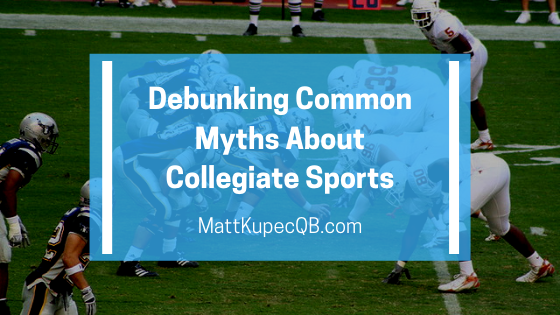Regardless of the sport or level, collegiate sports are a realm of opportunity for high school athletes looking to continue their sport while pursuing higher education; they provide a variety of life skills including — but not limited to — time management, accountability, will power, and leadership — traits that resonate well in the professional world.
That said, for every benefit observed in collegiate athletics, there is usually a myth or misconception undermining its value. Collegiate sports have become a hotbed for such unfounded observations, and it is important that we keep these matters in check to foster student-athlete development and maintain interest.
Below are a few of the most common (and glaring) myths surrounding collegiate sports, along with explanations as to why they are false.
Myth: “Many D1 athletes pick easy majors to remain eligible”
Fact: This myth has existed for a long time, and unfortunately it shows little sign of slowing down in the foreground. Generally, many have been led to believe that higher level collegiate athletes tend to “declare the same majors — not necessarily because they have the same academic interests,” but because the majors are easy and will allow them to remain athletically eligible with little challenge (a term generally referred to as “major clustering”).
In reality, the vast majority of collegiate athletes — especially those attending D1 institutions — are more likely to emphasize their professional aspirations over their athletic ones, picking majors that they actually want to see through. While “major clustering” does occasionally occur, it does not happen enough to warrant the ugly stereotype to which many have defaulted when assessing student-athlete work ethic.
Myth: “The recruiting process only starts during an athlete’s senior year”
Fact: It is reasonable to assume collegiate recruiting does not begin until an athlete’s senior year — after all, this period tends to be a culmination of that athlete’s high school development, given that he or she has had the full four years to hone key skills, set records, and win crucial competitions.
However, it is common for high school athletes to interact with college coaches (and vice versa) at any point during their pre-collegiate career. Many coaches aim to pinpoint and establish communication with prospect athletes as soon as possible — sometimes as early as the athletes’ freshman year — and this is a product of today’s increasingly competitive collegiate coaching world.
Myth: “All coach correspondence equates to recruiting”
The previous section in mind, it is important to understand the distinction between recruiting and mere correspondence with a collegiate coach. The fact of the matter is, while college coaches put a fair amount of emphasis on direct recruiting each year, they also send out hundreds of thousands of general emails to various high school athletes each year; but this does not mean that all of these athletes are being recruited.
Generally, the easiest way to tell the difference is to establish whether or not the email is broad in nature (using language that is clearly generic and aimed at a wide range of recipients); this typically indicates that the correspondence is not recruitment-driven. Recruiting letters are almost always personalized and reflective of a coach’s research and scouting efforts.

